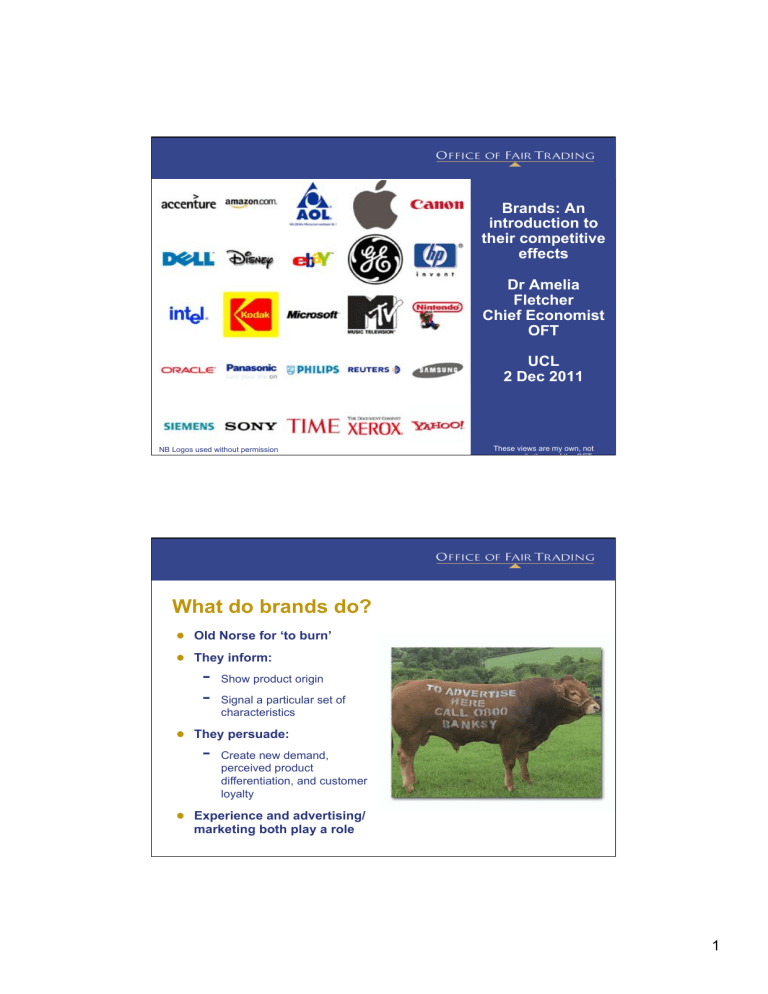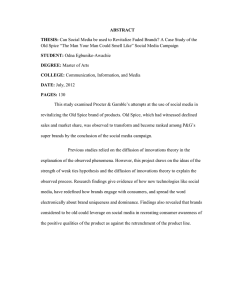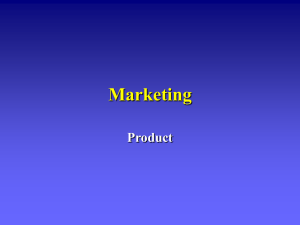- What do brands do?

NB Logos used without permission
What do brands do?
● Old Norse for ‘to burn’
● They inform:
Show product origin
Signal a particular set of characteristics
● They persuade:
Create new demand, perceived product differentiation, and customer loyalty
● Experience and advertising/ marketing both play a role
Brands: An introduction to their competitive effects
Dr Amelia
Fletcher
Chief Economist
OFT
UCL
2 Dec 2011
1
These views are my own, not necessarily those of the OFT.
1
Some pro-competitive aspects of brands
● Positive incentives for brand owners to maintain product characteristics
● Ease entry into new markets
Relative to starting from scratch
● Enhanced intra-brand competition (more homogeneous)
E.g. supermarket competition on brands
Although…..??
Some less positive properties of brands
● Can soften inter-brand competition
Due to more perceived product differentiation
And ‘must carry’ nature
● Can create barriers to entry
Brand proliferation strategies
‘Fighting brands’
● Can be used to justify restrictions on competition (‘free-riding’)
E.g. vertical restraints (RPM)
E.g. Law against ‘imitations’
2
The ‘free riding’ issue
● Brand-owners invest in product innovation and branding to create demand
● Downstream retailers can play a key role in this too
● ‘Free-riding’ can occur:
By lookalikes/imitations
By ‘no frills’ retailers
● This can damage brand directly , e.g. if poor quality provided…
● …or indirectly by disincentivising investment in brand and product innovation
‘Free riding’ - the counter-arguments
● Consumers are not often really confused
● Lookalike packaging can provide a useful (not misleading) signal
● More product homogeneity can enhance price competition
● Lookalike brands can grow into major brands in their own right
(i.e. entry strategy)
● There are more direct ways to incentivise retailer brand investment
3
Getting the balance right?
● EU guidelines on vertical restraints
Selective distribution outside Art
101(1), so long as criteria can be objective/necessary
Tricky question of internet selling?
● Case law on passing off/ lookalikes
Tough on replicas, which confuse consumers, and harm the goodwill of the brand
CPRs less relevant unless the
‘average consumer’ is misled
● Law on use of trademark for paid search?
!
After ECJ Interflora judgment
(2011)
A few thoughts on mergers and brands
● Inherently difficult to assess mergers between differentiated products (GUPPI helps)
● And issues re remedies
!
When is ‘brand-splitting’ possible, and when not?
● Further issues in assessment:
!
How easy would it be for a new entrant to replicate brand position/ goodwill?
!
How to assess the ability of prospective buyers of a divested brand to invest in it effectively?
!
What re-positioning is expected post-merger?
!
When assessing margins, is brand spend variable or fixed?
(Does PPC for internet advertising change this?)
4
NB Logos used without permission
Brands: An introduction to their competitive effects
Dr Amelia
Fletcher
Chief Economist
OFT
UCL
2 Dec 2011
9
These views are my own, not necessarily those of the OFT.
5





